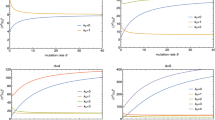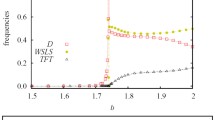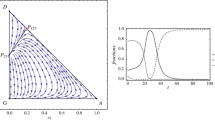Abstract
In this paper, we study the effect of stochastic fluctuations in payoffs for two strategies, cooperation and defection, used in random pairwise interactions in a population of fixed finite size with an update according to a Moran model. We assume that the means, variances and covariances of the payoffs are of the same small order while all higher-order moments are negligible. We show that more variability in the payoffs to defection and less variability in the payoffs to cooperation contribute to the evolutionary success of cooperation over defection as measured by fixation probabilities under weak selection. This conclusion is drawn by comparing the probabilities of ultimate fixation of cooperation and defection as single mutants to each other and to what they would be under neutrality. These comparisons are examined in detail with respect to the population size and the second moments of the payoffs in five cases of additive Prisoner’s Dilemmas. The analysis is extended to a Prisoner’s Dilemma repeated a random number of times with Tit-for-Tat starting with cooperation and Always-Defect as strategies. Moreover, simulations with an update according to a Wright–Fisher model suggest that the conclusions are robust.








Similar content being viewed by others
References
Antal T, Nowak MA, Traulsen A (2009) Strategy abundance in \(2\times 2\) games for arbitrary mutation rates. J Theor Biol 257:340–344
Broom M (2005) Evolutionary games with variable payoffs. C R Biol 328:403–412
Ewens WJ (2004) Mathematical population genetics: I theoretical introduction. Springer, New York
Fudenberg D, Imhof LA (2006) Imitation processes with small mutations. J Econ Theory 131:251–262
Fudenberg D, Nowak MA, Taylor C, Imhof LA (2006) Evolutionary game dynamics in finite populations with strong selection and weak mutation. Theor Popul Biol 70:352–363
Hofbauer J, Sigmund K (1998) The theory of evolution and dynamical systems. Cambridge University Press, Cambridge
Kaplan H, Hill K, Hurtado AM (1990) Risk, foraging and food sharing among the Ache. In: Cashdan E (ed) Risk and uncertainty in tribal and peasant economies. Westview Press, Boulder, pp 107–144
Karlin S, Levikson B (1974) Temporal fluctuations in selection intensities: case of small population size. Theor Popul Biol 6:383–412
Karlin S, Taylor P (1975) A first course in stochastic processes, 2nd edn. Academic Press, New York
Kroumi D, Lessard S (2021) The effect of variability in payoffs on average abundance in two-player linear games under symmetric mutation. J Theor Biol 513:110569
Lande R, Engen S, Saether B-E (2003) Stochastic population dynamics in ecology and conservation. Oxford University Press, Oxford
Lambert A (2006) Probability of fixation under weak selection: a branching process unifying approach. Theor Popul Biol 69:419–441
Lessard S (2005) Long-term stability from fixation probabilities in finite populations: new perspectives for ESS theory. Theor Popul Biol 68:19–27
Lessard S (2011) Evolution of cooperation in finite populations. In: Sigmund K (ed) Evolutionary game dynamics. American Mathematical Society, Providence, pp 143–171
Li C, Lessard L (2020) Randomized matrix games in a finite population: effect of stochastic fluctuations in payoffs on the evolution of cooperation. Theor Popul Biol 143:77–91
Li C, Ji T, He QQ, Zheng ZD, Zhang BY, Lessard S, Tao Y (2019) Uncertainty in payoffs for defection could be conductive to the evolution of cooperative behavior (preprint)
May RM (1973) Stability and complexity in model ecosystems. Princeton University Press, Princeton
Nowak MA (2006) Evolutionary dynamics. Harvard University Press, Cambridge
Nowak MA, Sasaki A, Taylor C, Fudenberg D (2004) Emergence of cooperation and evolutionary stability in finite populations. Nature 428:646–650
Otto SP, Whitlock MC (1997) The probability of fixation in populations of changing size. Genetics 146:723–733
Parsons TL, Quince C (2007) Fixation in haploid populations exhibiting density dependence I: the non-neutral case. Theor Popul Biol 72:121–135
Parsons TL, Quince C (2007) Fixation in haploid populations exhibiting density dependence II: the quasi-neutral case. Theor Popul Biol 72:468–479
Rousset F, Billiard D (2000) A theoretical basis for measures of kin selection in subdivided populations: finite populations and localized dispersal. J Evol Biol 13:814–825
Rousset F (2003) A minimal derivation of convergence stability measures. J Theor Biol 221:665–668
Stollmeier F, Nagler J (2018) Unfair and anomalous evolutionary dynamics from fluctuating payoffs. Phys. Rev Lett 120:058101
Tarnita C, Ohtsuki H, Antal T, Fu F, Nowak MA (2009) Strategy selection in structured populations. J Theor Biol 259:570–581
Taylor PD, Jonker L (1978) Evolutionary stable strategies and game dynamics. Math Biosci 40:145–156
Uecker H, Hermisson J (2011) On the fixation process of a beneficial mutation in a variable environment. Genetics 188:915–930
Wu B, Altrock PM, Wang L, Traulsen A (2010) Universality of weak selection. Phys Rev E 82:046106
Wu B, Traulsen A, Gokhale CS (2013) Dynamic Properties of evolutionary multi-player games in finite populations. Games 4:182–199
Zeeman RC (1980) Populations dynamics from game theory. In: Nitecki ZH, Robinson RC (eds) Global theory of dynamical systems. Springer, New York
Zheng XD, Li C, Lessard S, Tao Y (2017) Evolutionary stability concepts in a stochastic environment. Phys Rev E 96:032414
Zheng XD, Li C, Lessard S, Tao Y (2018) Environmental noise could promote stochastic local stability of behavioral diversity evolution. Phys Rev Lett 120:218101
Acknowledgements
D. Kroumi was supported by the Deanship of Scientific Research (DSR) at King Fahd University of Petroleum and Minerals (KFUPM) through Project No. SR181014. É. Martin and S. Lessard were supported by the Natural Sciences and Engineering Research Council of Canada (Undergraduate Student Research Award and Discovery Grant No. 8833, respectively). We thank three anonymous referees for helpful comments to improve the paper.
Author information
Authors and Affiliations
Corresponding author
Additional information
Publisher's Note
Springer Nature remains neutral with regard to jurisdictional claims in published maps and institutional affiliations.
Research is supported in part by the Deanship of Scientific Research (DSR) at King Fahd University of Petroleum and Minerals (KFUPM) and the Natural Sciences and Engineering Research Council of Canada.
Appendices
Appendix A: A First-Order Approximation
Note that \(|\eta _i|<M\), for \(i=1,2,3,4\), which yields \(|\bar{P}(x)|\le M<1\) for any x in [0, 1]. Using Taylor’s theorem, we obtain
where \(\xi \) is a random variable that depends on \(\bar{P}(x)\) such that \(\xi \in (0,\bar{P}(x))\) if \(\bar{P}(x)>0\) or \(\xi \in (\bar{P}(x),0)\) if \(\bar{P}(x)<0\). This leads to
If \(\bar{P}(x)>0\), we have \(1\le 1+\xi \le 1+\bar{P}(x)\), which leads to
If \(\bar{P}(x)<0\), we have \(0<1+\bar{P}(x)\le 1+\xi \le 1\), which leads to
since \(|\bar{P}(x)|\le M<1\). Combining these inequalities, we get
where K is a finite constant. Then, we have
On the other hand, by using condition (3), we have
We conclude that
Appendix B: Calculation of Summations
Using the elementary arithmetic identities
we get
and
Appendix C: Simulation Data
This appendix contains the simulation data in Cases 1 and 2 under a Moran model (Figs. 9, 10) and a Wright–Fisher model (Figs. 11, 12). For a population size going from 2 to 20 and parameter values \(\delta =0.02\), \(\mu _b=2\) and \(\mu _c=1\), the fixation probabilities \(F_C\) and \(F_D\) are calculated from \(10^6\) repeated runs for each value of the scaled variance \(\sigma ^2\) in a uniform probability distribution.
Rights and permissions
About this article
Cite this article
Kroumi, D., Martin, É., Li, C. et al. Effect of Variability in Payoffs on Conditions for the Evolution of Cooperation in a Small Population. Dyn Games Appl 11, 803–834 (2021). https://doi.org/10.1007/s13235-021-00383-2
Accepted:
Published:
Issue Date:
DOI: https://doi.org/10.1007/s13235-021-00383-2








